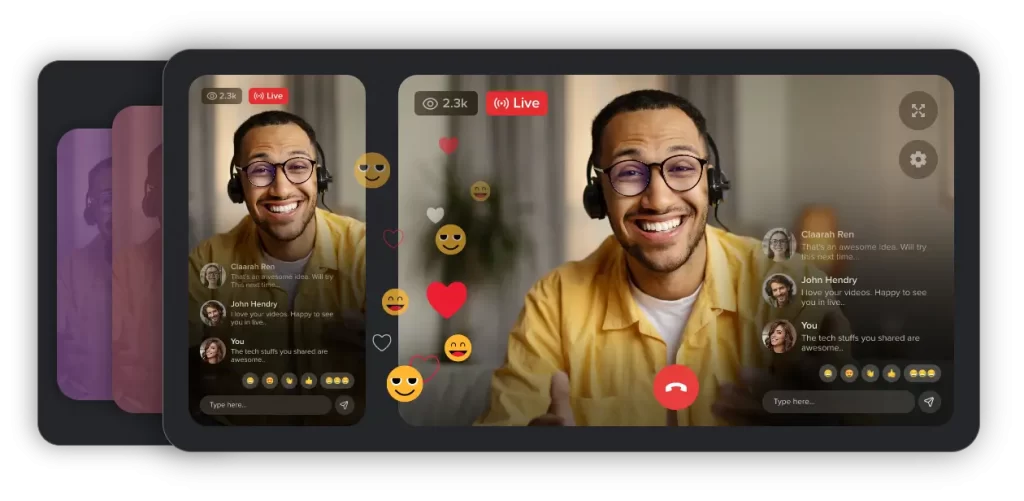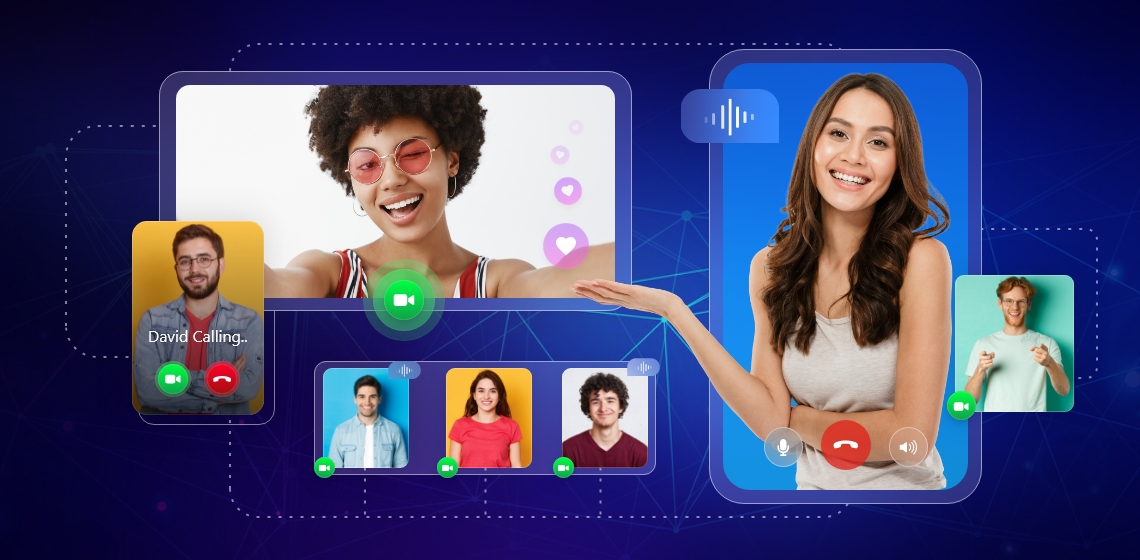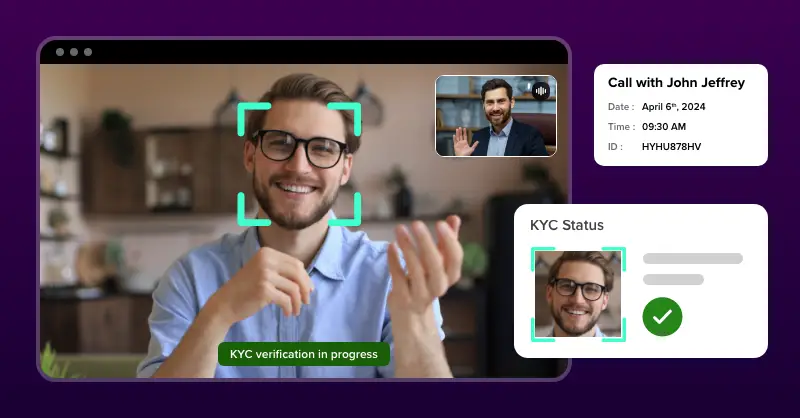What is In-App Live Streaming: The Ultimate Guide [2025]

In-app live streaming is a feature that allows users to broadcast real-time video content directly within a mobile app. This article discusses the technology behind, its use cases, key features, and a lot more.
Do you agree that Live streaming now plays a big role in many online platforms?
Just 10 mins from opening your social app, you’ll get a notification of someone you follow going live. For a webinar, workshop or a fun conversation, creators love to meet their followers.
It’s true that, these days, anyone with a smartphone can reach people worldwide in real-time. This change has had an impact on many fields, from software to education.
And the secret is – in-app live streaming. This feature allows users to broadcast live video right from mobile apps. This breakthrough has changed how users interact with content and each other.
Now, if you’d like to know what is in-app live streaming, this article is for you. In the next 5 minutes, you’ll learn everything about this technology, its benefits, use cases and key features.
Ready?
Table of Contents
What Is In-App Live Streaming?
In-app live streaming is a technology that lets users broadcast and watch live video in mobile apps. With this technology, people can create and view live content without switching to other apps or websites. This is the thing that sets it apart from traditional platforms that need separate apps or web pages.
In-app streaming provides a smooth experience for content makers and viewers. Mobile tech has grown and the Internet has gotten faster. People now want content instantly more than before.
This technology works in different types of apps. You’ll spot it in social media, games, learning, and even health apps. It’s almost everywhere – for showing off products, streaming events live, answering questions, and teaching skills.
Key Benefits Of In-App Live Streaming
Before we get any further, let’s look at some of the major advantages of using live streaming in apps. There are several reasons why you’ll need live streaming for your business.
We’ve curated a list you must know.
1. It’s Super-engaging
Live video streams really get people so excited. It is more fun to watch something that is broadcasted live than the pre-recorded content, right? That’s because you get to see people in real-time, and actually feel whatever they do on live is authentic and not scripted. It basically connects with the viewers that any recorded content.
Have you felt this – when you’re watching live, you feel like you’re actually there with the streamer. This is also a reason why people love to hop in live streams just to look at what the person they follow is up to, for real.
From a business perspective, this drives a lot of viewers and keeps them on the app for a long time.
2. Real-Time Interaction
Comments on pre-recorded content are great. But, what’s real fun is the opportunity to interact with the favorite influencer/ star on live. You simply can ask them stuff, and they can answer really quick. While it matters to the streamer to keep things real and responsive to retain viewer trust, the audience feel more personally connected, wanting to hang on the content.
3. Authenticity
When you’re watching live, you’re seeing things as they happen. No one’s setting it up or following a script. You just get to see the real person talking, or what’s really going on behind the scenes at a company.
This realness is what makes people trust your product/ service more. It doesn’t matter if it’s a boss who’s talking to customers or just some influencer showing what they’re up to. Simply put, it makes the person or company seem more down-to-earth and easier to relate to.
4. Independent Broadcasting
In-app live streaming lets users become broadcasters themselves. It’s like putting the power to create content in everyone’s hands. Anyone with a good idea can share it with the world.
Got a smartphone? You can start your own live stream. You can share experiences, thoughts, or talents with others.
For businesses, this means they can encourage user-generated content. For people using these apps, it’s like getting a stage to be yourself. You can show off who you really are and what you’re into.
Plus, it’s a great way to find your tribe – you know, other people who like the same stuff you do.
5. Monetization Opportunities
Live streaming in apps can help people earn money. If you are a streamer, you can make money out of ads, sponsorships, or fans who want to contribute. Some apps let viewers buy gifts or tokens to support streamers they like.
For businesses, this is another easiest way to promote their products to millions of viewers. This will eventually increase sales, convert leads and attract more revenue.
Key Technical Aspects of In-App Live Streaming
In-app live streaming can sound fun and engaging. But there are loads of technical aspects that are involved behind the working of the technology. Let’s explore each of them one-by-one.
We’d like to breakdown the entire working into 3 main processes:
- Video and Audio Compression
- Streaming Protocols
- Network and Transmission
Here is the a detailed note one each process:
1. Video and Audio Compression
Before a stream is transmitted, their data must be processed and brought down to smaller chunks to avoid speed and performance degradation. This is where you’ll need to focus on compressing both the video and audio data.
To do this, you’ll need the following:
- Codecs
- Bitrate management
- Codecs
Codecs are the hardware- or software-based processes that compress raw audio and video data before transmission and decompresses it for playback. Both these processes are important to significantly reduce the amount of data that needs to be sent over the network.
If the data is not compressed, huge chunks of data might have to be transmitted, which will slow down the streaming, and cause serious performance issues.
To do this you’ll need 2 different codecs.
- Video Codecs
- Audio Codecs
Video Codecs
- H.264 (AVC): Most often mobile apps use this codec to achieve a good balance between compression efficiency and computational requirements.
- H.265 (HEVC): Want a more advanced codec that’s 50% better than H.264? You’ll need the H.265 codec, which handles compression and maintains quality. However, while this codec requires more processing power and might affect battery life on mobile devices, it performs efficiently on CTV devices, providing a high-quality streaming experience on larger screens without significant impact on performance.
- VP9: This is an open-source codec developed by Google that is primarily used on YouTube. It offers compression efficiency similar to H.265 but the licensing costs are comparatively low.
- AV1: This codec was developed by Alliance for Open Media. It promises even better compression when compared to H.265 and VP9, on the other hand, it requires significant computational resources.
Audio Codecs
- AAC (Advanced Audio Coding): AAC is an audio codec for streaming that offers excellent sound quality at relatively low bitrates. It’s particularly effective for music and speech.
- Opus: This is an open-source codec that excels in both speech and music compression. It offers low latency and a wide range of bitrates, making it adaptable to varying network conditions.
2. Bitrate Management
Bitrate management in live streaming is about controlling the amount of data sent per second. This is very important for delivering smooth video to viewers whatever be their internet speed.
Streaming platforms use adaptive bitrate, which adjusts video quality based on the viewer’s connection.
- Higher bitrates mean better quality but require faster internet.
- Lower bitrates work on slower connections but reduce video quality.
The goal ultimately is to find the right balance between quality and stability. This is where we’ll useeEncoders compress the video in real-time, so that we can achieve the best possible quality within the chosen bitrate.
Some platforms automatically adjust bitrates, while others let streamers set them manually. Overall, good bitrate management makes sure that your viewers get the best possible experience without buffering or lag.
Here are 2 different ways you can manage bitrate streaming.
- Adaptive Bitrate Streaming (ABR)
ABR is a method where the streaming solution is set to automatically adjust the quality of a video stream real-time based on the viewer’s available bandwidth and CPU capacity.
This is undoubtedly the best way to make sure that viewers enjoy the highest quality stream without much buffering and interruptions.
- Bitrate Ladder
This one is an old-style way of controlling the number of bits used per second.
A bitrate ladder includes a collection of different encodings at varying quality levels and bit rates for the same video content.
For instance, a ladder could include a 360p version, a 720p version, and a 1080p version of the same video file at different data rates.
The streaming client has the capability to switch between those different editions without interruption so that it offers optimal watching experience regardless of changes in internet speed or bandwidth.
2. Streaming Protocols
- HLS (HTTP Live Streaming)
HLS, the live streaming protocol, developed by Apple stands as one of the most supported protocols for live streaming.
Now, what’s the deal with how it functions? It splits the whole stream into a series of small file downloads using HTTP.
Each file has a brief playback time from the full stream. While it’s great for compatibility and can adjust bitrates, it adds more delay (10-30 seconds) than RTMP.
- RTMP (Real-Time Messaging Protocol)
Macromedia first made RTMP for their Flash Player, and people still use it a lot to send live streams to servers.
It has a short delay (2-5 seconds) but doesn’t work well for playback on many mobile devices.
- WebRTC (Web Real-Time Communication)
WebRTC is a free open-source project that lets web browsers and mobile apps communicate in real-time through simple APIs.
It aims to have very little delay (less than a second) for direct communication between users. And that is why it is perfect for video conferencing and interactive live streams.
- SRT (Secure Reliable Transport)
SRT, an open-source video transport protocol, helps to improve streaming performance on unreliable networks during live broadcasts.
It works well to deliver high-quality video even when the user’s network quality is poor. SRT also offers other advantages such as the ability to recover lost packets, encrypt data, and keep an eye on network health.
- DASH (Dynamic Adaptive Streaming over HTTP)
Just like HLS, DASH allows high-quality streaming of media content over the Internet from regular HTTP web servers. It adapts the bitrate to suit the viewer’s connection strength.
One fascinating thing about DASH is, it works with any codec and supports smooth streaming of both on-demand and live content.
3. Network and Transmission
- Error Correction and Packet Loss Recovery
No one can avoid packet loss when the internet condition is quite unpredictable. But there are 2 main techniques that are commonly used to mitigate this:
- Forward Error Correction (FEC): This method adds extra data to the live stream.
It helps the receiver rebuild lost packets without asking for them again plus it sends more data overall, but can cut down on any noticeable delays when the network drops packets.
- Automatic Repeat reQuest (ARQ): This is a reactive approach involving the receiver requesting retransmission of lost packets.
ARQ renders perfect reconstruction of the original data, it can introduce additional latency.
- Content Delivery Networks (CDNs)
CDNs play a key role in live streaming setups that are really big. They spread servers across different locations to store and deliver content.
When someone wants to watch a stream, the nearest CDN server sends it, cutting down on delay and making the stream actually look better.
- Multi-CDN Strategies
To make things even more reliable and faster, many streaming services use multiple CDNs.
This means they work with several CDN providers and send viewer requests to the CDN that’s performing best at that moment, based on real-time data.
- Edge Computing
Edge computing moves data storage and computation nearer to end-users cutting down on delays and bandwidth usage.
For live streaming, edge computing helps with tasks such as real-time video transcoding, packaging, and content moderation. You know? This leads to quicker and more effective content delivery when compared to other technologies.
Low Latency: A Key Factor In In-app Live Streaming
Low latency refers to the time difference between an event happening at the source and viewers seeing it on their screens. In live streaming reduced latency makes the experience feel more ‘live’ and closer to real-time.
Latency plays a very important role in interactive events and when quick information delivery is really the focus of the business.
The effect of low latency extends beyond user satisfaction – it has an impact on stream engagement, performance, and even the core purpose of some streaming applications.
Here’s why your live streams need to have low latency:
- Provides a more immersive and “live” feeling for viewers
- Reduces frustration caused by noticeable delays
- Allows for timely responses to comments and questions
- Can be a key selling point for your streaming service
- Keeps viewers more engaged and connected to the content
Use Cases for In-App Live Streaming
- User Conversations
Live streaming in apps helps people communicate with each other in real time. Users can discuss things and share their thoughts as they happen.
This particularly works well for apps that focus on specific interests. People who like the same things can connect easily and have conversations over it.
2. Streamlining Operations
Companies can use live streaming in their apps to make work easier.
They can do things like:
- Train people who aren’t in the office
- Hold team meetings
- Make big announcements to everyone at once
This way, all workers get the same info at the same time, no matter where they are.
It’s also handy for:
- Checking on things from far away
- Showing how products work in real time
- Helping customers with their problems
3. Marketing Tool
In-app live streaming is a great tool for marketing people. Many companies are using it in different ways, to promote their products and services. They use streaming for introducing new products, hosting live events, or interacting with their audience in real time.
Live streaming creates a sense of excitement. It makes people want to watch content right away to get updates on special deals and unique content about a product/ service.
- Sales
Live streaming can boost sales in a business. It lets brands talk directly to their customers. They can in fact show off products, answer questions, and offer deals, to keep customers more informed about a product/ service and drive them for sales.
This is actually a great way for customers to decide whether or not they want to buy a product or service, by seeing and learning about it in a stream.
- Event Coverage
You can use live streams to conduct meetings, music shows, or sports games. People can watch and join in from anywhere using your app. Anyone can watch the event that’s happening on the other side of the world, right at the comfort of their own home.
How Industries Use In-App Live Streaming?
1. Online Gaming and Esports
Honestly, Live streaming is big in gaming. Apps like Twitch and YouTube Gaming let gamers show their play to the audience on live. Players can show their gaming tricks and talk to viewers while they play.
Now, some games have streaming features built right into them. This means players can share their games without using other apps. This option is particularly popular in mobile games.
2. Education
Live streaming in apps has changed a lot about online learning. Teachers can now give live classes and lessons right inside learning apps. Students get the opportunity to learn from lectures as it happens, ask questions to the staff, and talk with teachers and other students.
For example, a learning app could offer live help sessions where students will get personal teaching and feedback.
3. Financial Services
Banks and financial institutions use live streaming to offer real-time financial advice, market updates, and webinars. This is a great way for building trust with clients by offering expert advice virtually.
A financial planning app could host live Q&A sessions with advisors where users can ask questions about their investment strategies or retirement planning.
4. Retail
Retailers make use of in-app live streaming to showcase new products, offer exclusive discounts, and provide live demos.
One quick example is, an e-commerce app could host a live stream featuring a new clothing line. Wouldn’t that be interesting?
Viewers could literally see the product live, ask questions about sizing and fit, and make purchases directly within the app.
This is a great way to make sales happen right away!
5. Social and Communities
You can notice a lot of streaming happening on social media apps these days. It is an incredible way to connect and engage with each other in real-time.
When there is a stream happening, users can share experiences, thoughts, or talents with their followers.
Plus, community apps can host virtual events like book clubs, gaming nights, or fitness classes where members can participate and interact in real-time, and enjoy the company of like-minded individuals.
6. Telehealth
In healthcare, in-app live streaming enables remote consultations, live webinars, and real-time medical advice. Telehealth apps can connect patients with healthcare providers for real-time communication and consultation.
It is an easy option to improve access to healthcare and a convenient way for patients to receive medical care without visiting hospitals every time.
Key Features of In-App Live Streaming
Live streaming itself is an interesting feature. But, do you know there are a lot more you could add to this technology to make it more interactive and fun for your users?
Let’s look into such features, one by one.
- Cross-Platform SDKs: These allow developers to integrate live streaming across multiple platforms, ensuring compatibility with various devices and operating systems.
- Push Notifications: These alert users when a live stream starts, encouraging real-time participation.
- Moderation Tools: These help maintain a safe environment by allowing hosts to manage comments and filter inappropriate content.
- Reactions and Emojis: These let viewers express themselves quickly during a live stream, enhancing engagement.
- Mentions: This feature allows tagging of other users, fostering community interaction.
- Video and AR Filters: These enhance the visual appeal of live streams and provide entertainment value.
- Screen Sharing: This allows broadcasters to share their device screen, useful for tutorials or demonstrations.
- RTMP Transcoding: This ensures high-quality video delivery across various devices and network conditions.
- Rich Media Support: This allows integration of images, videos, and links into live streams.
- Cloud Video Recording: This enables storage of live streams for later viewing.
- High-Quality Streaming: Support for high-definition video is crucial for a professional-grade streaming experience.
Building In-app Live Streaming With MirrorFly
In-app live streaming has transformed how we consume and create content within mobile apps. As a technology, streaming has opened up new possibilities to drive engagement, entertainment, and sales across various industries.
Now the question is, how to add in-app live streaming to your apps?
We’ve got you a better deal – MirrorFly!
MirrorFly is a real-time communication provider that offers CPaaS solutions for web and mobile apps. You can simply download the APIs and SDKs, comprising over 1000s of features and enable live streaming on your apps.
The key highlights of MirrorFly include,
- 100% Customizable
- Full Source Code Ownership
- Unlimited Chat & Call
- SIP & VoIP Call
- Hire a Dedicated Team to build an app
- Customize Security
- Whitelabel Solution
- Flexible Hosting (On-premise/On-cloud)
- Activity feeds
- Chatbot
- Profanity filter
- Topic Based Chat
- Multi Tenancy
- Pre-built UIKits + SDK
- Upload Huge Files
- Built on Microservice Architecture
- Development in Native & Hybrid Languages
- Scalability over 1 billion conversations
- Low Code SDKs
- Supports 100+ third-party integrations
- 24*7 Technical Support
And there’s a lot more!
For businesses and developers, MirrorFly could make it a breeze for adding in-app live streaming to apps with its customizable solution. If you are all impressed with the solution, you can talk to MirrorFly experts right away and get started with building live streaming for your users.
Why wait, while you can build live streaming in the next few hours?
Looking To Build Your Own Whitelabel Live Streaming App?
Develop highly scalable, interactive live streams on your web & mobile apps with White-label live streaming SDK.
Contact Sales100% Customizable
Topic-based Chat
Multi-tenancy Support

Frequently Asked Questions
What do you mean by live streaming?
Live streaming is the transmission of video and audio data to viewers over the Internet in real-time without storing or recording in the first place.
What industries use in-app live streaming?
Live streaming is highly beneficial for the following industries: education, online gaming, esports, financial services, retail, telehealth, social, and communities for real-time interaction and high monetization options.
What are the benefits of in-app live streaming?
Live streaming provides better engagement and monetization options for businesses and individuals to facilitate meaningful interaction between hosts and viewers with chat, voice, and video capabilities.
How does in-app live streaming differ from regular streaming?
In-app live streaming lets you have complete control and transfer the audio and video in real time. In contrast, regular streaming requires additional apps or websites to play back your recorded streams.
What are the core features of in-app live streaming?
The core feature of in-app live streaming includes and starts with high-quality live video streaming, monetization options, social media integration, in-app chats, custom security, subscriptions, notifications, and more.



